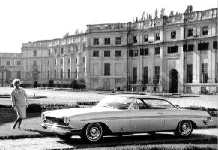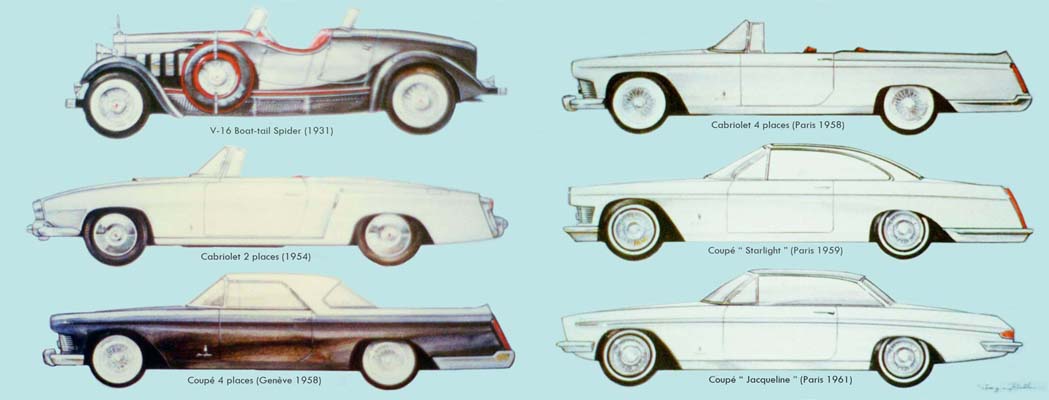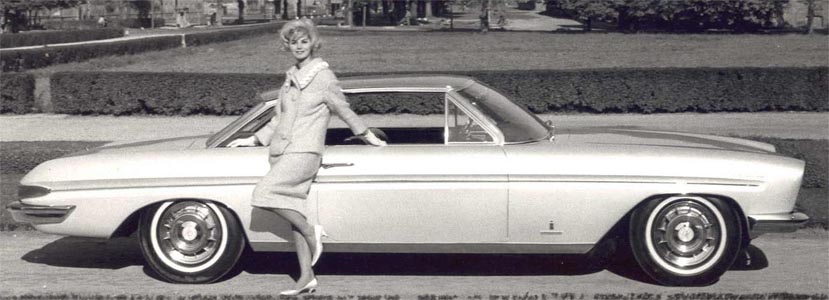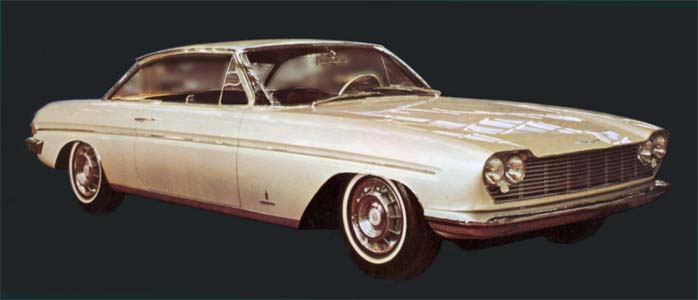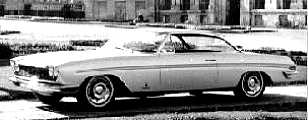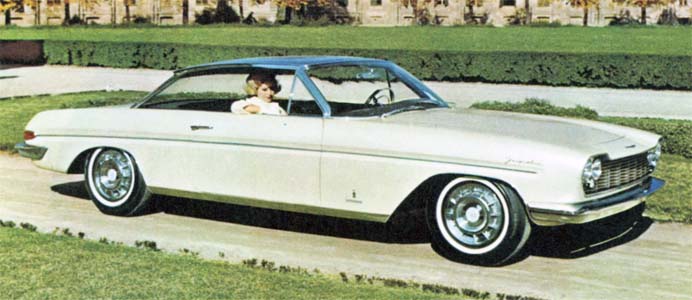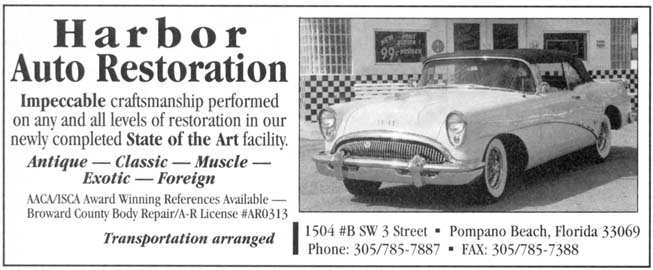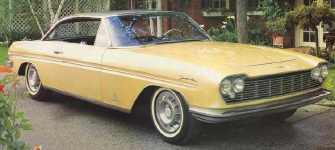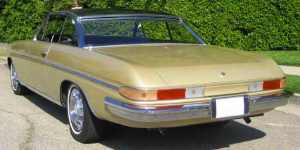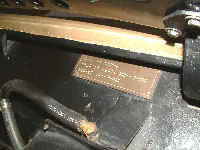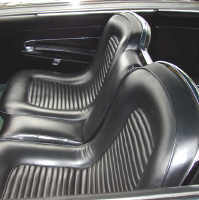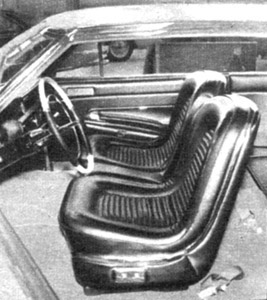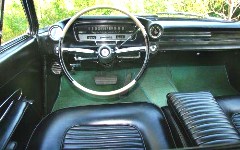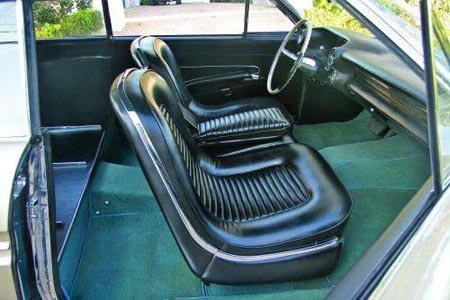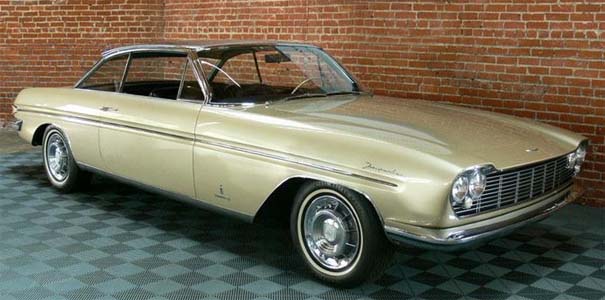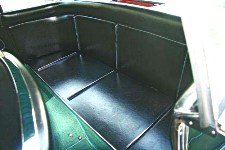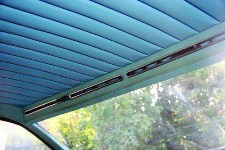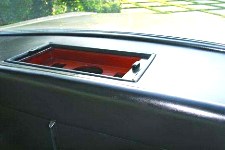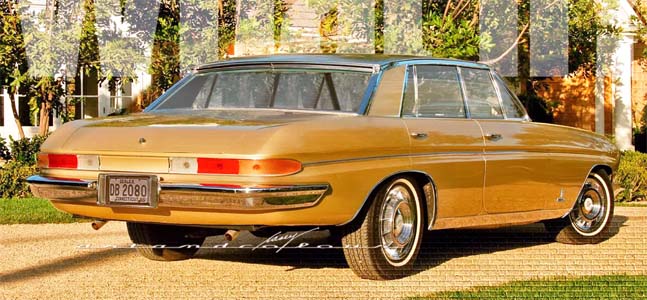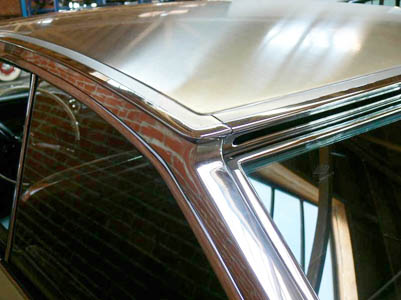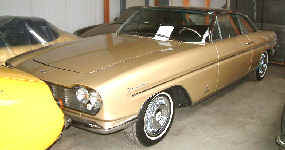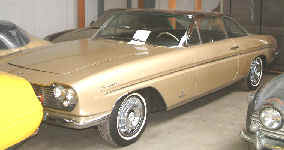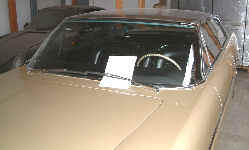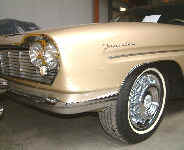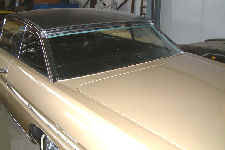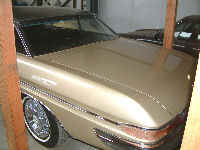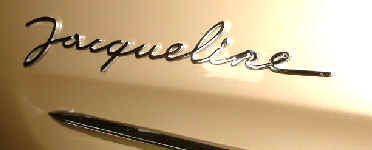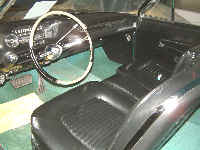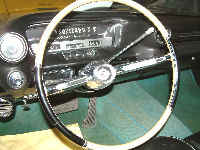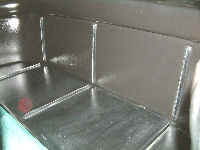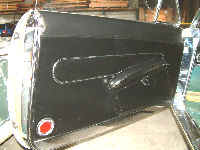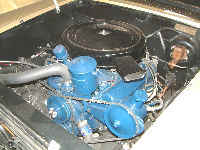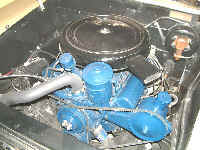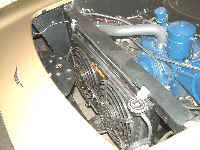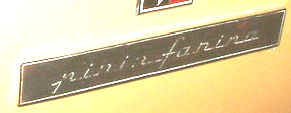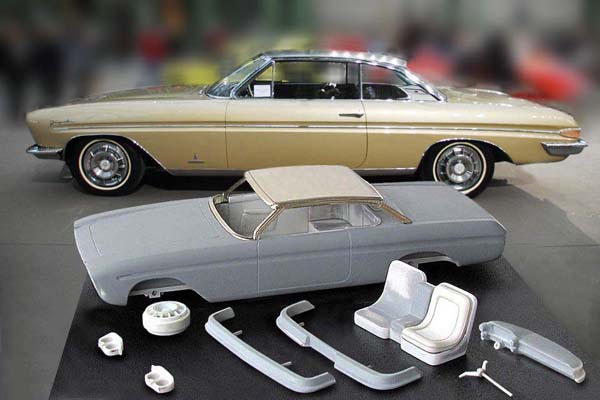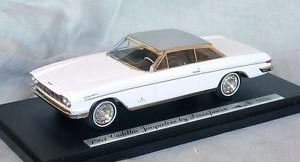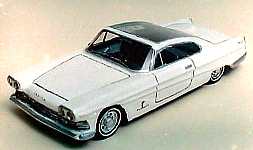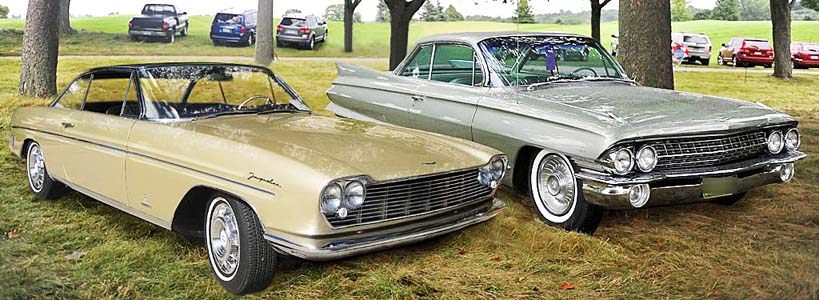Jacqueline
is sold
A Swiss friend of mine who often visits Scottsdale, AZ, called me early in 2001
to inform me of the aborted sale of some collectible Cadillacs belonging to a collector in
France. About half a dozen of these cars were planned to be sold during the January 2001
edition of the annual Barrett-Jackson [Kruse] auction. As it turns out, the cars
never made it across the block. In fact, it appears some of them never even made it
to Scottsdale, from Europe. It seems the Kruse auctioneers thought the
vendor's reserve price on one of the cars was much too high.
That car was the rare Jacqueline coupe, a (former) pushmobile
designed by Pininfarina for European auto shows of the early sixties.
My friend was interested in the car and asked me if I knew anything about it.
He had got a copy of an appraisal that had been done of the car, in Paris, France, in
November 1996. He knew my interest in Cadillac cars and was surprised, later,
at the wealth of information about Jacqueline that he found in this, The (new) Cadillac Database©.
I too have been interested in Jacqueline for some 40 years. My
late mother and my lovely daughter both have that same name. In addition, I was
working at UNESCO, in Paris, the year Jacqueline made her first public appearance
at the Paris Salon.
I remember also talking about her with Pininfarina's PR people, back
in 1975. The facts and photos I got from them, at that time, have been included in the Database
since its inception in 1996. I am always pleased when I am able to add a new fact or
more reliable historic information about her. Facts are what count in The (new) Cadillac Database©, not fiction.
It seems, however, that my "facts" just didn't cut it with an
irascible French used-car salesman who claims to have been involved with Jacqueline's
destiny over the last few years.
After this person rubbed me once too often the wrong way, I thought perhaps it
was time to set the record straight by creating this special page devoted exclusively to
the PF Jacqueline. I say again: the bulk of information included herein
came directly from Pininfarina themselves and from other very reliable sources in
the world of rare, costly, collectible cars.
If you are familiar with the car and can contribute constructively (and not in
a threatening tone!) to correcting any errors, omissions or misconceptions, I shall
be glad to hear from you :

or

History: 1975-76
I corresponded with Pininfarina in late 1975 and early 1976 but was
not able to gain answers to all my questions. Here are those I asked, about Jacqueline,
inter alia, as well as the [mostly incomplete] answers I was given at that
time. Perhaps an Italian Cadillac aficionado visiting this site could shed some more
light on the interesting topic of the special Pininfarina cars that were
allegedly mounted on Cadillac's bespoke Eldorado Brougham chassis:
Q. What were the Brougham chassis numbers used for the five special PF
creations [barring the 1930 roadster in the above introduction]?
A. We do not have that data.
Q. What colors were these cars? What color was the trim and upholstery?
A. (a) The Cadillac Skylight convertible displayed at the 1958 Paris show [October
'57 or October '58?] had a silver-gray metallic body with bright red leather trim. The
2-door coupe [it had no name] exhibited at the 1958 [???] Geneva Motor show was
black with turquoise leather interior. The Cadillac Starlight 2-door coupe
exhibited at the 1959 Paris show was white with brown leather upholstery. The Cadillac Jacqueline 2-door coupe exhibited at the 1961 Paris
salon was ermine white and had black leather upholstery
[my comments: the appraisal that was done, in
Paris, in November 1996, mentions a black, Naugahyde interior; in addition (though
not specified in the appraisal) the car was gold-colored at that time].
[PF say Jacqueline had no nameplate at
the Paris show and that the latter was added for the Turin show [nonetheless, the
photo I have of Jacqueline, in Paris (below), already features the nameplate on
the front fenders]
Q. If they were sold, who were the buyers? Do the cars still exist, and if so
where are they located? If they were destroyed, when and where did this occur?
A. We do not have the answers to these three queries, except to say that we still own the Cadillac Jacqueline.
After receiving these initial replies to my questions, I was still somewhat in
the dark as to the existence of custom Eldorado Brougham models fitted out by the
Italian coach builder, so I had an Italian- speaking office colleague call Pininfarina,
in January 1976, to make some additional inquiries. Following that call, and after some
more research in their archives, Pininfarina wrote again on January 26, as
follows:
Here are the answers to your additional questions:
Q. Were the Skylight coupe and convertible built on the Brougham
chassis?
A. No, they were built on the Cadillac Sixty-Special chassis .
Q. What was the wheel base of these two models?
A. It was 330 cms. (i.e. 130 inches)
[My comment: the wheel base of both the Series
60 Special and the Eldorado Brougham was 130" in 1959 and 1960; since
the Geneva Show takes place in March each year, and since the wheel base of the 1958 Series
60 Special is 133", obviously the Skylight coupe could not have been
shown at Geneva in 1958; if it was mounted on the 130" wheel base chassis
it must have been shown at Geneva in 1959]
Q. Did the two foregoing models have air-suspension?
A. No, they had mechanical suspension with hydraulic shock absorbers
[My comment: in that case, these two
cars were NOT mounted on the chassis of the bespoke Eldorado Brougham]
Q. Which of the two models above were exhibited first?
A. The Skylight coupe was exhibited in Geneva from 13 to 23 March, 1958, while
the Skylight convertible was shown in Paris from 2 to 12 October 1958.
[My comment: once again, in 1958, the wheel base
of the Series 60 Special was 133"; so, either the year of the Show was NOT
1958 or the the Skylight coupe was not mounted on a chassis with 130" wheel
base;
the coupe version shown at Geneva in 1958 was shown again in Turin (I
guess in May 1959) with a modified hood fitted with a broad air scoop)]
Q. What was the chassis number of the Pininfarina Jacqueline coupe?
A. We do not have that information. The chassis no longer exists [inferring that
it did exist, at one time!]; it has been replaced today (?) by a tubular structure.
[My comment: I think it most unlikely that this pushmobile
was ever mounted on the Eldorado Brougham or any other Cadillac chassis for that
matter. This is the opinion also of Frank Tetro who was commissioned, in 1996,
to mount the pushmobile on the chassis of a pre-owned 1960 Cadillac Eldorado Biarritz]
Q. Is the Jacqueline coupe for sale?
A. No
[My comments: ... I was hoping I might just get lucky !]
Q. Did the Starlight and Jacqueline models have original Brougham
wheels or only turbine wheel covers?
A. We do not have the answer to that question.
In my humble opinion, therefore, founded on these concise answers to my
questions [and I have still the original correspondence with Pininfarina for
anyone who is not convinced], the Cadillac Eldorado Brougham models with alleged
custom bodies by Pininfarina ... all are a fallacy. For what reason would Pininfarina
have installed the Jacqueline coupe first on an Eldorado Brougham (or
any other Cadillac) chassis, and then have gone to the trouble (and expense) of removing
it later and creating, instead, this pushmobile on a complex and probably costly
tubular structure? And what became, thereafter, of the Eldorado Brougham chassis
that was (said to have been) used?
My guess is that both the Starlight coupe with Plexiglas top (1959-60)
and the Jacqueline coupe (1960-61) were pushmobiles. Let's hear it
from anyone who ever saw these two splendid creations move under their own power [...that
is up to 1996, when Jacqueline was put on a pre-owned 1960 Cadillac Eldorado
Biarritz chassis].
Like many of us, I would have loved to find out that Jacqueline was,
perhaps, the "missing" Eldorado Brougham for 1959 [engine #100],
the one that is supposed to have been dropped in the harbor at Detroit while it was being
loaded on a freighter bound for Genoa, Italy. In fact, Cadillac factory records indicate
without a shadow of doubt that only 99 chassis were built; EVERY SINGLE ONE OF THEM
HAS BEEN ACCOUNTED FOR [check this page].
But, like you, I like to dream.
The photos of
Jacqueline in this frame all are from Pininfarina's own archives
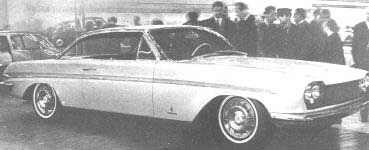
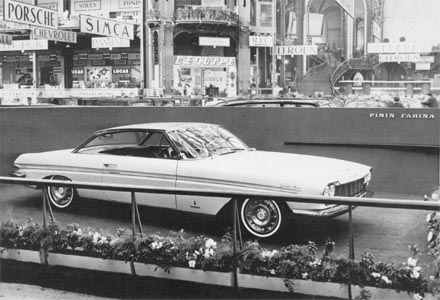

The Pininfarina stand at the Paris Salon,
October 1961
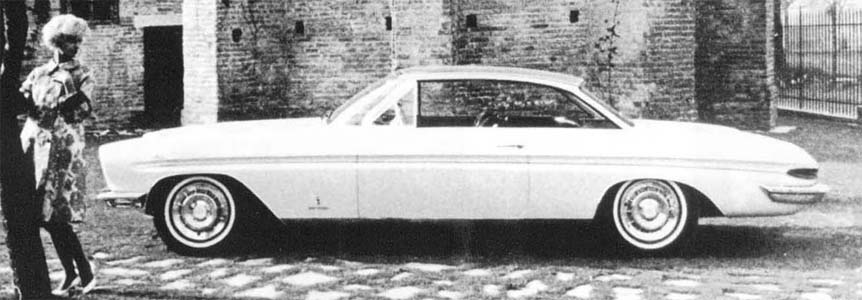



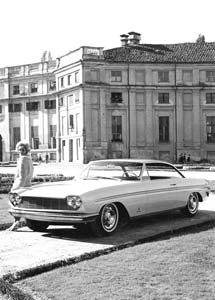
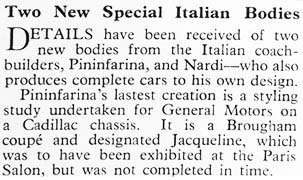
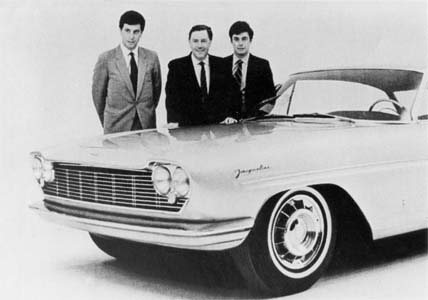
Right: Sergio Pininfarina and his
sons pose with Jacqueline (date unknown)
|
History:
1976 - 1996
During this period, I saw Jacqueline only once.
That was at the Geneva Motor Show, in Switzerland, in March 1991. She was part
of a display of special, custom cars exhibited by Barclay cigarettes [part of
B.A.T., the British American Tobacco, group], under the attractive title: Barclay
Fascination Cars. My press credentials enabled me to get a close look at the
"car". I was able to crawl under it and discover for myself that there were,
effectively, neither engine, nor transmission, nor any mechanical components of any kind
on this "car". Even the dashboard instruments were the dummy kind and the
windshield and windows all were made of of plastic. Obviously this pushmobile
never was intended to be driven. She consisted simply of the Pininfarina-built Jacqueline
body shell mounted on an intricate, tubular framework with two trailer axles and wheels.
The wheel covers were identical to those used on the 1959-60 Cadillac Series 60
Special and Eldorado models (i.e. the Brougham [sedan], Seville
[coupe] and Biarritz [convertible].
In the mid-nineties, Jacqueline was acquired from
the PF museum in Italy, it seems, by Belgian Ferrari dealer, Philippe
Lancksweert. I guess that his connections with PF, through their
mutual business interest in Ferrari automobiles enabled him to secure the sale. I have no
idea how much Jacqueline cost him but am guessing around $40K.
The car was featured at a Christie's auction of Exceptional Motor Cars
in August, 1994 [Lot #086]. There is no indication of who the owner/vendor was at
that time. Christie estimated it would fetch around $50,000-65,000, but the car apparently
did not sell.
I got Philippe's name from Michel Kruch, in Brussels. I found Michel's number,
quite by chance, through www.google.com; Michel
had an ad running on the Lamborghini Web page in January, 2002. I called him,
January 2002, and he filled in some more blanks for me. Michel said that he had acquired Jacqueline,
later, from Philippe, in partnership with a French collector, Hervé Willems (whom I
initially thought was of Belgian origin, on account of his name). Michel confirmed that
Philippe L. had bought Jacqueline directly from PF; he confirmed also
that the car was already painted gold at that time (i.e. the color of Jacqueline
as featured in the Collectible Automobile article in January 1996 [see below].
Michel subsequently sold his share in the "car" to Hervé Willems, alias Irving
Willems of Tarzana, CA. Michel confirmed that Hervé (or Irving) subsequently had
sold Jacqueline to Alain-Dominique Perrin, CEO of the French Cartier
group. That fact was confirmed directly to me, by Mr. Willems, in November 2006.
Soon after that sale went through, Mr. Perrin commissioned Florida auto restorer, Frank
Tetro, to make Jacqueline a drivable machine. That fact too was confirmed by Mr.
Willems in 2006.
All photos here
are from Collectible
Automobile
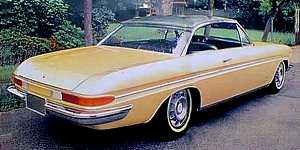
Jacqueline, after a repaint from white to
gold
(a job believed to have been done in the Pininfarina
workshops)
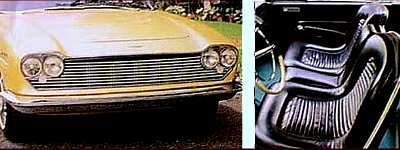
Note again the 1959 steering wheel (right)

No sign of any spare wheel in this trunk !
|
History:
1996
The Article in Collectible
Automobile
[January, 1996]
The photos published in CA, in January, 1996, show
a gold-colored Jacqueline, although she was originally painted ermine
white. From the information I got from Michel Kruch, it appears that she was repainted in
Italy, in the early nineties, before being sold to Philippe L. of Belgium. All
photos I have of Jacqueline [before publication of the CA article] show
her to be ermine white. She was also still white when I saw her at the Geneva Motor
Show in March, 1991. As mentioned above, apparently she had been repainted
"gold" by PF before she was sold to Mr. Lanksweert.
In the CA article, Jacqueline was
reported (correctly) to be owned by a collector in Tarzana, CA, by the name of Irving
Willems (see previous paragraphs); Irving is certainly easier to pronounce in the USA than
"Hervé". The article mentions also a second, alleged 4-door Jacqueline
model, said to have been also on show in Paris, in 1961. I have my doubts on that score,
since I was there, but I will listen to anyone who can confirm the rumor ... and supply a
picture! My belief is that the 4-door model to which the writer refers was a regular 1960 Eldorado
Brougham, designed by Fleetwood, but also assembled by PF; that car may
indeed have been also on display in Paris, although I don't remember having seen it there.
In all my contacts with Pininfarina, in the seventies,
no "second" Jacqueline model was ever mentioned. Among the artist's
drawings (top of this page) that depict the only known PF creations
allegedly built on the Cadillac chassis, only one Jacqueline is
shown. As may be seen in existing photos of that PF creation, she was fitted
with the same "turbine-vane" wheel covers as used on all Series Sixty
Special and Eldorado models (including the Eldorado Brougham) built
in 1959 and 1960. Perhaps PF hoped to sell GM/Cadillac on the idea of a PF
designed Eldorado Brougham coupe for 1961 and subsequent years.
However, with the exception of the wheel covers, the instrument
panel and a 1959 steering wheel, the car had no real, Cadillac "identity".
Moreover, Cadillac had lost enough money on each Brougham sold from 1957 through
1960 to even consider prolonging the program after 1960.
At the time the CA article was published, this car was
not yet "mobile"; it was still just a rolling chassis or, as its restorer said
later, a pushmobile.
The Conversion from "Pushmobile"
to "Automobile"
by Harbor Auto
Restorations, Florida
(summer and fall, 1996)
History:
1997 - 2000
Soon after Harbor Restorations completed the
installation of a full drive-train, suspension and other mechanical components,
Jacqueline
headed back to Europe (presumably in the full ownership of Alain-Dominique
Perrin, CEO of Cartier). She was on show at the Bagatelle Concours
d'Elégance in Paris, in 1998 and again in 2000. In between times, she did one more
return trip to the USA where she stole the show at Pebble Beach, CA, in 1999. The
venue was a joint event entitled Concorso Italiano (the Italian Concours
d'Elégance)
staged by Pininfarina and sponsored by GM's Cadillac Motor Car Division.
In preparation for the latter New Millennium show at Pebble
Beach in 1999, PF contacted me, in Switzerland (just before Gita and I emigrated
to South Carolina) to ask if I might know the whereabouts of any of the six
PF
models described at the beginning of this page. The only cars of whose location I was
vaguely aware at the time were the 1930 V-16 roadster, the 1953 2-seater roadster
believed to have been built for Luigi Chinetti, NY Ferrari importer, and Jacqueline
(which I firmly believed at the time was still in Turin).
Of the show, Chairman Sergio Pininfarina of Industrie
Pininfarina - S.p.A. said: I am very pleased that Cadillac, major sponsor of the
Concorso
Italiano, has dedicated an important part of this event to highlighting the historic
creative and industrial collaboration between Cadillac and Pininfarina.
Working on Cadillac automobiles has always inspired us to reach for designs that express
the distinctiveness of this singular marque. We at Pininfarina are proud of our
historic close association with the prestigious Cadillac brand. I am particularly
enthusiastic about this relationship because of the technical excellence it has produced
and the personal relationships that have developed.
GM Vice-President and General Manager of the Cadillac Motor Car
Division, John F. Smith added: We are pleased to use this setting, surrounded by the
many historic and beautiful cars here at the Pebble Beach Concours d'Elégance,
to celebrate this long-lasting and beneficial relationship.
A number of Cadillacs built as a result of the
"relationship" between Cadillac and Pininfarina were on show there
including, inter alia, the unique 1930 V-16 boat-tail roadster, formerly owned by
the wealthy Maharajah of Orccha, in India, the regular 1959 and 1960
Eldorado
Brougham models, a number of Allanté roadster models and, finally,
Jacqueline.
I understand that the renowned Italian coach builder had been able to borrow the
former pushmobile from its then (alleged?) owner, Cartier Chairman,
Alain-Dominique Perrin.
In line with that showing, Cadillac collaborated with
Pininfarina
to publish a beautiful (and rare) booklet entitled Cadillac & Pininfarina -
an Enduring Relationship. Illustrated with many photos, mainly from the PF
archives, the brochure relates the alleged long "collaboration" between the
American and Italian auto giants. It is asserted that it had begun some sixty years
earlier, in 1931, when the young Battista Farina (nicknamed Pinin - the
"little one") had been commissioned by an Indian Maharaja to build a boat-tailed
speedster (allegedly for tiger hunting!) on the bespoke V-16 chassis. It is my
opinion, however, that there was no "collaboration" between Cadillac and
Battista for this project; Cadillac merely supplied the chassis and engine.
The "collaboration" apparently continued on into the
nineties with the manufacture of the PF-designed Cadillac Allanté
roadster. This part is factual, but most of the filler-material in between is
highly exaggerated. I had an Italian friend inquire about the statement: Pininfarina
designed and built one-off ("off" what?) special bodies on
Cadillac chassis, especially (my emphasis) for use by Hollywood stars and
magnates. The PR people in Turin were unable to produce a single name of any
such "Hollywood star" or "magnate", nor any archival photo of any such
special body.
Excerpt from the
1999 booklet by Cadillac & Pininfarina
The text continues: The coachbuilder also produced a number
of show cars using Cadillac mechanical underpinnings such as a two-seat convertible in
1954 and a four-seat in 1958. So far as I know, the 2-seater convertible was NOT a
show car; it was a regular customer order, long believed to have been commissioned by New
York Ferrari importer, Luigi Chinetti, and built (completed) in 1954 on a
Series 62
Cadillac chassis for 1953. Information surfaced in 2007 indicating that this very special,
easily recognizable car may have belonged (before Chinetti?) to King Leopold of Belgium.
Indeed, the King was involved in a spectacular car accident between San Biaggio and
Cortina d'Ampezzo, in the Italian Alps, on country road #SS51. The date of the accident is
not known but is believed to have occurred in late 1956, the year of the winter Olympics
held in that region of northern Italy. It seems that the accident was never reported in
the (world) press, perhaps because it was the second time the King had gone off the road
in a car. The fist (recoded) time was in 1934 when his wife, Queen Astrid, tragically had lost her life. Look
at the photos, below, taken at the crash site; the car that the King was driving in Italy
looks identical to PF's custom 2-seat convertible.
|
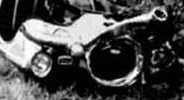
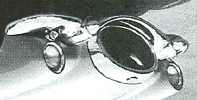
Left: the overturned car; that circular front
grille opening is unmistakably PF
Right: this is an upside-down view of the original grille of the 1953-54 custom PF
roadster;
unless PF built TWO identical roadsters, I would say that the overturned wreck and
the
PF special used later (?) by Luigi Chinetti are one and the same car
|
As to the 4-seater PF special, i.e. the Skylight
convertible (which is more like a 6-seater), it does indeed fall into the "show
car" category; it is illustrated above (second image box, central pair, RH side). The
latter is believed to have had Cadillac mechanical underpinnings. Its sister car
[they formed a pair in 1958], was the Skylight coupe to its left, above.
Rediscovered in New York, many years later, it was found to have been mounted on a 1957
Cadillac chassis and drive-train. I am convinced that Cadillac had no hand in either
of these projects, other than having manufactured the Cadillac mechanical
underpinnings that were used (without any Cadillac involvement) to power the PF
design.
In the same paragraph, we read: A notable 1961 show car was
a handsome coupe built on a Cadillac chassis (again, my emphasis)
named Jacqueline in homage to then-First Lady
Jacqueline Kennedy. In this specific case, the
evidence is indisputable: Jacqueline was never motorized (that is, until
1996). This fact was confirmed by the professional automobile restorers at
Harbor Restorations,
in Florida, who in 1996 were faced with the arduous task of fitting the Jacqueline
body shell onto the chassis of a pre-owned and mostly derelict 1960 Cadillac Eldorado
Biarritz. The floor pan was absolutely flat and could not have accommodated a
Cadillac drive shaft of that period or earlier. The instrument panel was unwired and none
of the instruments ever had been functional; the steering wheel was bolted in place under
the dash; there were no holes nor any openings in the firewall for connecting any
mechanical components, such as steering, brakes, electrical wiring.
I wonder who, if anybody - at Cadillac - did the proofreading
for the final publication of that PF booklet. It says, inter alia: the relationship
between Harley Earl and Battista Farina produced the evolutionary design and manufacturing
of the ultra luxurious Series 2 Eldorado Brougham during the 1959 and 1960 model years.
Cadillac shipped chassis from Detroit to Italy where bodies designed and built by
Pininfarina craftsmen (again, my emphasis) were installed. Later, it
adds: Pininfarina was responsible for the redesign of a second edition
(Eldorado
Brougham), including production (construction?) of the bodywork and final
assembly in Italy ... The fact is that Earl was retired by the time Phase 2 of the
Brougham
program was implemented and, secondly, the 1959 and 1960 bodies were DESIGNED BY
FLEETWOOD. They used the stock Cadillac, 130" wheel base chassis, including
most of the mechanical components of stock models of those years. These included the
floor pan (Jacqueline's original floor pan was totally FLAT), lower body interior panels,
seat structures, instrument panel, dashboard, door pillars, hinges, inner door panels
(these were modified but used stock hardware), lower front bumper, grille blades
(but not
the bullets, for a cleaner less cluttered look), headlamp bezels, rear wheel skirts, wheel
covers (not the cast alloy turbine wheels used on the 1957-58 Broughams) and a
modified lower rear bumper. The forward-opening hood was an exclusive design; it was only
45 inches wide compared to the hood of the stock Cadillac models that stretched to 61
inches. None of the body panels nor any of the glass could be interchanged with stock
Cadillac models.
The Cadillac chassis and other usable hardware (crated separately), including
many pre-formed body panels, were shipped to Genoa, Italy (located about 100 miles west of
Turin). There, Pininfarina merely did the final fitting and assembly
at
the new Via Lesna industrial complex, using the clay bucks Fleetwood had
built and sent over. In his recollections about the 1959 Brougham, Pierre
Ollier, a retired GM-Cadillac designer who was closely associated with its design and who
owned two ’59 Broughams in the late seventies, mentioned how it had taken three weeks
of negotiation with the Italian customs before the Brougham clay models could
enter the country; at that time, a law prohibited the import of plaster objects, to
protect Italy’s statue industry!
The cars were individually assembled on a stationary production line
(photo
below). Where required, sheet metal was cut and formed on male wooden forms then welded
together. Seams were hammer welded without the use of solder. Potential rust spots were
filled with sealer. Chrome trim was made from brass castings. Protective splash pans and
flanges were placed under the car to prevent the rocker panel from scraping on steep
driveways. The hood, trunk and doors all fit perfectly and tolerances along the panel
edges did not vary a fraction of an inch. However, because of all the hand-fitting that
went into the manufacture, it was made clear in the service instructions that
certain
body parts, including sheet metal and moldings may have to be reworked if replacement is
necessary. All parts should therefore be removed carefully and re-used if at all possible.
Any new part must be matched against the removed part to make certain that it is identical
in shape and size before installation is attempted.
|
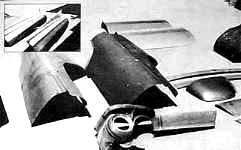

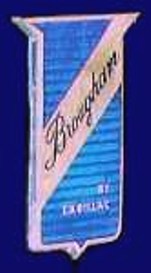
[Left] preformed body panels were shipped to Turin,
Italy, to be assembled and fitted (Photo: Pierre Ollier collection)
[Center] stationary assembly line at Pinin Farina's plant in Turin; three Broughams
nearing completion (Photo: PF archives)
[Right] A badge like this one identifies the 1959 and 1960
Eldorado Brougham models;
no mention of Pininfarina here
|
Sure, it all looks good when you just skim over
the Pininfarina text but, when you look at the detail, the impression is that PF is
pulling on a blanket of which Cadillac deserves to have the majority share. Surprisingly,
there is no PF badge on the car (have you ever seen a car "designed and built
by PF" that did not carry the company emblem?). Only a small, oblong chrome
plaque bearing the words Brougham, by Cadillac, on a blue enamel, cloisonné
background, graces the front fenders just ahead of the front doors, above the chrome side
spear on the 1959 Eldorado Broughams.
As regards Jacqueline, the PF booklet mentioned above
describes her in these terms: The low tapered line highlights the lightness of the
roof panel on this Pininfarina-designed one-off body (my emphasis)
that
debuted at the Paris Motor Show (in 1961). Note that PF asserts (as I do)
that only one of these was made (cf.: "one-off" - more correctly
"one of") and that the word "body" is used in lieu of
"automobile", or "car", or "vehicle".
|

Pebble Beach - 1999
|
History:
2001
The Article in RetroViseur [May]
The appraisal by Mr. Sene was still fresh in my mind (and on my desk) when a
third article was published about Jacqueline in the French auto-hobby magazine
RétroViseur,
#153, in May 2001. In a 5-page spread by Jean-Eric Raoul, illustrated with many
recent photos by Dingo, it was claimed, inter alia (and in error) that
220 Eldorado Brougham models were assembled by Pinin Farina in 1959 and
1960; the correct number is 200 units. The article mentions also the
PF Starlight coupe (with Plexiglas roof), shown at the 1959 Paris show:
|
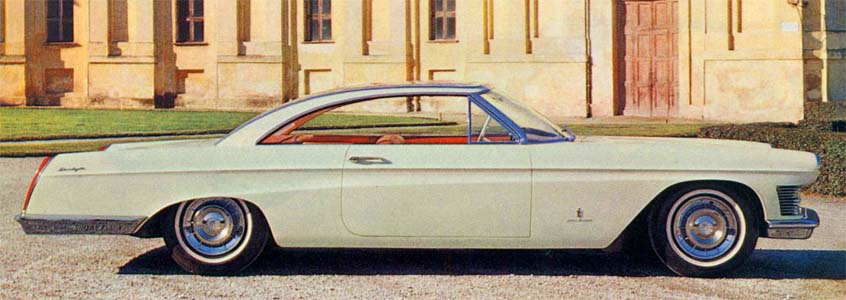
The Pininfarina designed Starlight coupe,
also with Brougham look-alike wheel covers
|
There is reference in the article to a single Jacqueline coupe
on show at the 1961 Paris Salon; this contradicts the story as told in Collectible
Automobile but confirms my own position. It is asserted also (as I too maintain) that
Jacqueline was a pushmobile, i.e. a body shell on wheels with no
mechanical components to speak of.
The writer asserted also that the now gold-colored car had never been
repainted. That does not tie in with the fact that Pininfarina had confirmed
to me in 1975 that the show prototype was painted ermine white (not a color easily
confused with "gold"). PF also had supplied at that time a
color slide (top
row, below) as well as some original ads that had been shot in Turin. I can assert also
that Jacqueline was still painted white when I saw her at
the Geneva Motor Show in March, 1991.
From what I have ascertained since, Jacqueline may have been repainted "gold" at the factory, around the early
nineties, when PF decided to upgrade the old paint job, possibly with a view to selling
the car.
|
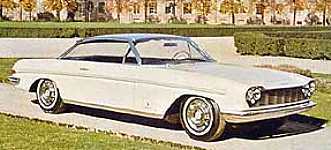
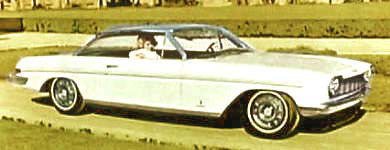
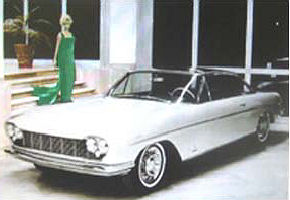
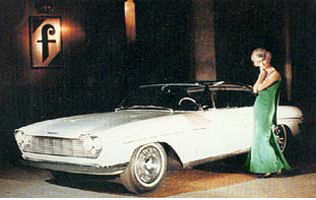
These photos appear to show
Jacqueline
in different colors; in fact they all are of the same, white car, but taken in different
locations,
under different lighting conditions and probably color-processed using
different techniques; the top two images are from a 6x6cm color
slide supplied to me in the mid-seventies by PF's consumer relations
department; second row, left, is from a period ad for
Pininfarina coach work; second row, right, is from another
PF ad
that appeared in the Swiss annual Automobil-Revue it seems
obvious from the background that these two photos were taken on the same day and in
the same location; on the third row you can see
two further publicity shots of a white Jacqueline (I believe the model in the
emerald green dress is the same one seen in
the RH photo above it; the one on the left features the same blonde, Italian (?)
model; the B&W photo, immediately above, is from
the book Cadillac Allante by Giorgio Bocca; none of these pictures show a
gold-colored car; despite the recent rantings and ravings
of "Mr. C", who claims to know more about
Jacqueline than me, I
am convinced that there only ever was ONE Jacqueline and this is it!
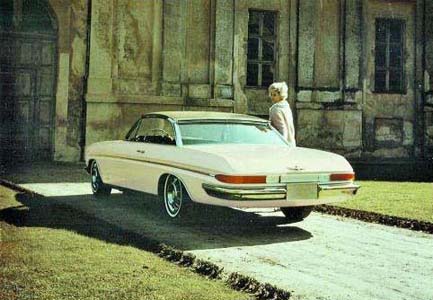

The color separation
process here does not show clearly that the car is actually
white with a polished, stainless steel roof
|
According to the writer, Jacqueline spent "many
years" in a Belgian "museum". The exact period and precise location
were not specified but, from my conversation with Michel Kruch, in January 2002,
Jacqueline
could not have been in Belgium more than a couple of years. I know for a fact that
Jacqueline
was, for most of her life, a part of PF's own museum collection in Turin, Italy.
At a date not specified in the article, it is said that
an un-named collector had seen the car in the Belgian museum. What museum? Michel Kruch
says the car never was in any museum in Belgium; if anybody (especially
any Belgian enthusiasts) ever saw this car in a Belgian "museum" please let me
know! That collector became interested in Jacqueline and decided to breathe life into
her. I assume
that collector was Hervé Willems (aka Irving Willems) of Tarzana, CA, and that he
saw the car in Philippe Lancksweert's Ferrari dealership in Brussels. Irving,
Philippe and Michel form a trio of Ferrari enthusiasts and racing aficionados that
apparently goes back a long way.
There is no indication in the French article how or when the car got from
Tarzana, CA, to Harbor Auto Restoration in Pompano Beach, FL. From Information I
got first hand from Willems, in November 2006, it was Alain-Dominique Perrin,
then CEO
(now former CEO) of France's Cartier group who bought the car from him (Willems)
in 1996 and had it shipped to Florida for the mechanical transformation ... or should I say
transmogrification?
With considerable difficulty, the body shell was mounted on a
pre-owned and rough-looking 1960
Cadillac Eldorado Biarritz chassis powered by a (replacement?) 1959 Cadillac motor by Tiano and Frank Tetro (see above). The tasks accomplished by
Messrs. Tetro include fitting a fuel tank, dashboard instruments, windshield and all
windows (on the PF showcar these were cut from Plexiglas), as well as working
lights all round and power window mechanisms. No mean task!
According to the RetroViseur article, Jacqueline's
owner (in May 2001) was Mr. Benoît Couturier, a Paris resident. I wrote that
person in July 2001, asking for some more information about Jacqueline and was
hoping to get some clarification for the apparently conflicting information I had got
directly from Pininfarina in the mid-seventies. I did get some snippets of
information from Mr. C. ... but mainly I got a lot of needless sarcasm! One thing
is certain he NEVER owned the car but was simply an agent for Alain-Dominique
Perrin.
The French Connection
(July-December, 2001)
Mr. C. sent me a couple of faxes (in July/August 2001) and a couple of
e-Mails (in November/December, 2001). His droll sense of humor as well as his
sarcastic and caustic tone were immediately apparent. In his first fax message, for example, he
asserted that all the information I had on Jacqueline was just hearsay and gossip
by people who only think they know the facts; he said I was wandering about in a
thick fog and that I was the world's champion at reporting half-truths!
Might I say, in my defense, that in the Foreword to
The (new) Cadillac Database©, it is stated quite
plainly that "facts" from different sources sometimes are
contradictory. Included here, therefore, are only those "facts" drawn from
the source(s) which, in my opinion, seem the most reliable. It is for you, the user,
to point out any errors, omissions or inconsistencies you may come across so that,
together, we can improve the Database and thus better serve the hobby.
Subsequently, I learned from a reliable source that Mr. C. is indeed a
very "difficult" person to deal with. I learned from the same source that
Mr.
C. is just a used car salesman, although he does cater mainly to wealthy clients with
a taste for high-end classic and collectible cars. Among his client's are some
European "big names", including a former wealthy former neighbor of mine who has
requested anonymity1. Mr. C.
apparently sold him a 1957-58 Eldorado Brougham. At any rate, based on my
own dealings with him, I would say Mr. C. is the kind of auto
salesman you want to avoid at all costs! When Mr. C. found out I had been in
contact with Alain-Dominique Perrin, he had to come clean and admit that he (Mr. C.)
never owned Jacqueline. My guess is that he was merely acting as Mr.
Perrin's agent (in fact, this was confirmed to me directly by Willems, in November
2006). Mr. C. initially claimed that HE had bought Jacqueline from
Willems in 1994 or 1995. In fact, and this was again confirmed later by
Willems, it was Perrin who bought the car; that was in 1996. Mr.
C. later admitted that Jacqueline was not built initially on a 1959
Eldorado
Brougham chassis but had been put later (1996) on a regular 1959 Cadillac chassis (in
fact, it was a 1960 model, according to the Florida outfit that did the work). He
mentioned a single, 4-barrel carb, whereas the '59 Brougham had the so-called
"Tri-Power" unit (three double-barreled carbs). He told me that Frank Tetro had
all the details. This was indeed confirmed to me, later, directly by Mr. Tetro.
Well, Mr. C., according to Frank, with whom I spoke on the telephone,
the engine and chassis are NOT from a 1959 Cadillac but from a
pre-owned 1960 Eldorado
Biarritz. Consequently, it should have the tri-power set-up. In
fact, recent photos of the engine compartment (taken in June, 2006) show a regular 1959
325HP engine and not a "Q"-type 345HP motor as used on all 1959-60
Eldorados,
including the Brougham).
The plot thickens!
Mr. C. said he was "absolutely convinced" that there
were two Jacqueline prototypes (did he get that "reliable
information" - because it was in print - from the article in Collectible Automobile?).
He claimed that "his" car was #1. He suggested that the one I saw in
Geneva (i.e. the one from Pininfarina's own museum in Turin and that was widely
photographed by the press in 1961/62) was not "his" car. So, then,
by Mr. C.'s account, the Paris show car must have been #2.
Take that with a pinch
of salt!
I am beginning to seriously doubt the ability of Mr. C., despite all
his ranting and raving, to provide the world with any reliable, factual information about
Jacqueline. He
even asserted that the Jacqueline shown at the Paris Salon in 1961 was NOT white
and referred me to a photo in a book on Cadillac published by France's EPA
group. I have in my vast
Cadillac book collection the
one published in 1985 by E.P.A. [Editions Presse Audiovisuel] entitled
Cadillac
- Toute l'Histoire; it is a translation of the book by Walter F. Robinson Jr. and
carries ISBN # 2-85120-236-7. This book does NOT include any photo of
Jacqueline (either in color or in B&W). Does any reader have the ISBN of the other
(alleged) E.P.A. book to which Mr. C. refers? Could it be Les Américaines,
by Nory and Martinez? My copy of that one unfortunately has remained in Switzerland. I
suspect that the photo to which he refers depicts a regular 1959 or 1960 Cadillac
Eldorado
Brougham and NOT Jacqueline.
With respect to Jacqueline's original color, I have a copy of
Pininfarina's Consolidated Annual Report for 2000 in which, on page 6, is an
original factory photo of Jacqueline in the company of a charming model
dressed in an emerald green gown (see above group of pictures). Note the second photo of
Jacqueline,
with the same model, gown and car, taken at night. If that car isn't white, then
"I am
a monkey's uncle!"
It was confirmed by my Swiss friend from Scottsdale that Jacqueline's
last owner was a wealthy French businessman with an extensive collection of Ferrari models
(this was Alain-Dominique Perrin - I had read about Mr. Perrin in an American hobby
magazine, a few years earlier; I knew that he owned also a red 1953 Cadillac
Eldorado,
and perhaps others too). He (my Scottsdale friend) mentioned what he referred to as
"a clique of European high-rollers" who congregated at the annual
Barrett-Jackson collectible-car auctions in his town; these (apparently) were Messrs.
Perrin, Willems, Kruch, Lancksweert and possibly also Mr. C. In my opinion we
could be dealing here with a sort of cabal, intended to boost to new heights the
now motorized
version of Jacqueline.
One of Cartier's office complexes is located near Fribourg, in
Switzerland; I knew this from driving past it frequently when we still lived in that
country. I was able to get the address off the Internet and shot off a letter
to Mr. Perrin
asking him kindly to confirm that he was, indeed, the current owner of Jacqueline.
I received his reply dated January 21, 2002; at that time he was in
London. He said: I can only confirm what Mr. Couturier has told you, i.e. that the
Cadillac Jacqueline has been sold and that the (new) owner wishes to remain
anonymous." As to my comments about Mr. C's rudeness towards me,
as well as his manifold and manifestly untrue assertions about Jacqueline, Mr.
Perrin said he did not know Mr. C. very well and recommended that I resolve the
issue directly with him.
Mr. Perrin's assertion in January 2002, confirming that he had sold
Jacqueline
in 2001, does not tie in with the information I got five years later (in November, 2006)
directly from Willems who asserted that Perrin had retained ownership of Jacqueline
up to 2006 and that he (Willems) had bought her back directly from Perrin that year. The
plot thickens even more.
_________________________________________________________________
1
At one
time I thought Jacqueline might be in the possession of this former neighbor as
he had bought already a Cadillac Eldorado Brougham from
Mr. C.
The dates of the possible transactions
seem close enough together to justify this assumption
(summer, 2001). This wealthy collector is very discreet about the cars in
his collection. I know he has an early V-16 phaeton, Fleetwood
style 4380 all-weather phaeton as well as a customized 1959
Eldorado
Seville town car alleged to have been commissioned by the late King Farouk of Egypt but now known to be the work of an
amateur customizer from Baltimore, MD.
Jacqueline
would have been a probably and interesting addition to that eclectic collection.
But, in all honesty, Mr. C., I don't really care WHO
owns Jacqueline; my only concern is that the TRUTH be
told!
Mr. C. goes "off his
rocker"
(December, 2001)
My innocent query to Mr. Perrin put Mr. C., into a fuming rage!
Mr. Perrin, it seems, had passed on my letter to him and this had set the cat among
the pigeons! Mr. C. contended that Perrin sold Jacqueline in May,
2001; this ties in with Perrin's own statement in January, 2002.
Read on, however, and you will discover a surprising "conclusion" to the
true (?) story of Jacqueline's ownership.
I still cannot believe the tenor of the fax I got from Mr. C. on
December 14, 2001. I wonder what could have been eating him? I suspect he was very
unhappy that I should have got so much (factual) information about Jacqueline
and that my Cadillac Database© on the Internet
was making all that information widely available to Cadillac enthusiasts around the world
... even to some who might have a special interest in Jacqueline.
Mr. C. seemed to prefer his "myths" (read "lies")
to my FACTS about Jacqueline! Those "lies" obviously were intended to
attempt to boost Jacqueline's value in the eyes of potential (unsuspecting)
buyers. Such buyers might not be too happy to find out that the story spun by
Mr.
C. is just that: a good story!
Needless to say, I rarely receive communications couched in such aggressive,
threatening language, although I do admit that my apparent single-mindedness of purpose
does seem, on occasion, to get some people's hackles up. The people who criticize me,
however, often are the very owners of what I shall call "questionable" Cadillacs
with whose history I happen to be familiar and that I see occasionally described
"inaccurately" (to say the least)! Some of these include the
Hartmann V-16 roadster of
1937, the so-called
Vatican
V-16 of 1938, a couple of
Eldorado Brougham
models, the alleged "unique" 1959 Motorama custom
special with in-dash TV, the equally alleged
"Farouk"
1959 Cadillac Eldorado town car, and now Jacqueline). People don't like
the truth if there's a chance it might diminish in any way the profit potential of their
special "baby".
The only "crime" of which I stand accused, as an auto historian,
member of the Society of Automotive Historians (SAH) and compiler/keeper of
The (new) Cadillac Database© on behalf of the
Museum
and Research Center of the Cadillac & LaSalle Club, Inc. (CLC), is that of
keeping said Database as factual, accurate and up-to-date as possible, for the
benefit of its hundreds of thousands of users (between its inception in May, 1997 and the
latest update of this page, the site has had more than a million "hits").
What a strange fellow, this Mr. C !
Judging by the tone and substance of his communications to me (excerpts below) and others that he has exchanged in
the past with a fellow Porsche enthusiast and friend of mine in Paris, in my opinion
"C."
shows all the symptoms of suffering from a serious psychotic condition. At the risk
of incurring his wrath before a duly constituted court of law, here or in France (where I
travel frequently) I will let you form your own opinion as to his "medical
condition." Here is what this very irate gentleman (?) had to say
(my comments
are incorporated directly in the text, in brown font, between square brackets):
December 14, 2001
Mr. Saunders, I thought my last message about the Cadillac
Jacqueline
was quite clear; it appears I am mistaken and that you are still "poking your nose in
other people's business" [Mr. C. uses an
unpleasant French neologism: fouillasser]. Mr. Perrin has passed
your letter on to me; you will never get any reply from him,
Mr."know-it-all-but-not-quite." Cartier is no longer at that address and Mr.
Perrin is no longer Cartier's CEO
[indeed, the
new CEO is/was Bernard Fornas, but Mr. Perrin did get my letter at that address and he did
have the courtesy to reply]. You never went to Tarzana and you never met Hervé
[I never said that I did; I said I had
"re-discovered" Jacqueline in Tarzana, CA in the article
published in Collectible Automobile in January, 1996]. Mr.
Perrin doesn't give a damn [in French: il se moque
complètement] about your address in Scottsdale
[I
had told Mr. Perrin that I hoped we might meet one day at one of the annual
Barrett-Jackson auctions there]. He has nothing to tell you about
Jacqueline.
The car was sold in May 2001 to someone whose name neither I nor Mr. Perrin will ever
reveal to you1
[my
emphasis]. As regards the car's history, I already gave you the details
once. Please forget us and the Cadillac [did
Mr. C.
actually believe that after sending me this venomous epistle, I would actually want to
"forget" him and the Cadillac; the only purpose it served was to pique my
interest even more]. Please don't waste time answering [this e-Mail]; there will be no further communication from
this end [he did write again, 48 hours later!].
I hope that I have been very clear about your "research"
[his quotation marks]. SO STOP EVERYTHING
[his own, threatening emphasis].
____________________________________________________
1 I did find out the name of the
"new" owner again ...in the summer of 2006. Read on !
Well, one thing is clear: Perrin obviously did own
Jacqueline at one time, just as I had surmised. I opine also that he may have
become suspicious that "she" was not all her vendor
["C."?] had made her out to
be. As may be seen, above, the "expert" appraisal done in Paris in 1996 is at
best inaccurate, at worst blatantly untruthful.
Until I found out more information, in the summer of 2006, I had to
accept Mr. C's word that Jacqueline had effectively been sold again in
May, 2001. As I said in a previous update, I expected we would hear from the
"new" owner in good time. And so it came to pass! By the way, it is rumored that Mr. Perrin has parted with much of his classic auto
collection (in addition to Jacqueline).
I told Mr. C. I could not understand his ire. I had concluded from the
tone of his first two messages that he simply lacked basic good manners. However, his
obvious desire to "shut me up" suggested to me that he might be trying to hide
something more. I assured him that I did NOT intend to (nor ever would) give up researching the
history of any car that I chose and that I thought was worthy of interest ( ... or that was
plain suspicious), nor would I ever refrain from publishing my findings in the
Cadillac
Database if I believed the facts to be true and essential to proper historical
accuracy; it was my goal also to try to protect potential buyers from unscrupulous or
untruthful auto vendors. I assured him that I would continue, as always, to keep secret
the identity of any Cadillac or LaSalle owner who wished to remain anonymous but, as to
verifiable facts or previously published information about a specific car or person, this
information would remain public. My goal, I said, was to gather and to publish only
facts
(or information from reliable sources) about the collectible Cadillacs we all own or
admire.
After asserting two days earlier that he would never write again, Mr. C.
e-mailed me once more (on December 16, 2001), threatening me with legal action (!!!) if I ever dared to publish again
a single word
about the Cadillac Jacqueline. Obviously he wanted to "muzzle the
press". Here is my own translation of his French original:
December 16, 2001
Sir [very official, very polite],
following your reply, I have sent a copy to Mr. PERRIN and another to Jacqueline's
current owner. The language of your communication is considered threatening
[orig.: (ce) sont des menaces pures et simples].
Be
warned that we forbid you to publish anything [else?]
about the Cadillac Jacqueline [is that the Royal
"we" or does he include Mr. Perrin and Jacqueline's new owner, as well
as himself?] At the slightest publication, despite our opposition, we
will produce your threatening [???] letter [in court?] and we will file a suit as appropriate.
Please stop harassing us with your inquiries about private property without due
authorization. I hope to never hear from you again.
Needless to say, Mr. C., I am trembling in my boots!
Naturally enough, Mr. C's uncalled for "epistolary
aggressions" of December 14 and 16, 2001 simply piqued my interest even more and I
have continued, tirelessly, to investigate this former pushmobile with the
intention of getting all the facts out in the open. A car like this can not easily
be hidden away, nor can it easily hide its true heritage. So, Mr. C., I
guess I'll be seeing you in court for having dared to print, in this Database,
more than just "a single word" about Jacqueline!
The current owner (summer 2006) has confirmed the change in ownership. Read on
!
History:
2006
(and temporary conclusion)
I was hoping to pick up some up-to-date information about the car during the
2002 and 2003 venues of the well-known annual Barrett-Jackson auctions at Scottsdale,
AZ. However, I heard from my friend there that although the major players in the
Jacqueline
"saga" were indeed in attendance again at the auction ... the car was NOT.
So perhaps it had indeed been sold in Paris and the new owner did not want it in
Scottsdale.
In June, 2006, a Belgian friend of mine was
in Antwerp to pick up a car he had shipped over from the USA. He was very surprised to
find, in one of the hangars at the docks, the car in the photo-block below. We
later talked at length about his discovery when Gita and I spent a few days at his home in Brugge while
attending the Grand International Cadillac Meet in Zeebrugge during the first weekend in
September, 2006.
The car was being shipped to a Ferrari
dealer in California. Ferrari? Remember Philippe Lancksweert and Michel Kruch
from Belgium? Indeed, the consignee was a company called Heritage Classics on
Santa Monica Boulevard in West Hollywood, California. Some CLC members who attended the
Cadillac Grand National in Hollywood, this year, may even have visited the
place.
I inquired of Heritage Classics if
the car belonged to them and if it might be for sale. They answered "yes" to the
first part of the question and "no" to the second. Then, a few days later, I got
an eMail from the "new" owner ...none other than Mr. Hervé [Irving] Willems!
Wasn't he the guy who bought the pushmobile
from the Belgians, Lancksweert and Kruch, back in the early nineties? It seems that
Willems is the head honcho at Heritage Classics. My friend in
Scottsdale confirmed that he, Kruch, Lancksweert and Perrin (and possibly Couturier too)
all are "Ferrari buddies." In 2004, Willems and Lancksweert drove together
a 275 GTB Ferrari in the classic TourAuto, a GT-class annual European
rally; in this thirteenth edition the participants drove from Tours (remember the
Robert
Keyaerts Cadillac Museum at Langeais, near Tours) to St. Tropez on the Mediterranean
(remember Brigitte Bardot?) For the sixteenth edition, next year, the venue is
Le
Mans.
I don't think Jacqueline will be
competing...
Fact 1: Willems owned the car in the early
nineties. Fact 2: Willems owned the car again in 2006. This begs the question:
did Willems ever actually sell Jacqueline to Perrin and, if so, why did he buy
her back? What has Mr. C. got to do with all this? In my humble opinion the
whole Jacqueline story stinks of combinazione (the Italian equivalent of
cabal). It would make a good movie title: Five Men and a Pushmobile (Lancksweert,
Kruch, Willems, Perrin, Couturier and Jacqueline).
I ask myself: is it possible that Perrin
found out Jacqueline was not all she had been made out to be, i.e. a custom
creation by Pininfarina on the 1959 Eldorado Brougham chassis? Is it possible the
sale (to him) had been conditional on the car passing muster with the French DOT
(les
Mines)? These guys can make your life a misery, even with the best of stock
(American) classic cars, so this "concocted custom job" must have had them
rolling in the aisles.
Whatever the actual story, the fact is that
Jacqueline
now has come around full circle, back to square one so to speak. What next?
History:
2007
What next? Well, the car came up for
sale at the Monterey Sports & Classic Car auction (lot #586) organized by RM
Auctions on August 17 and 18, 2007. Not surprisingly, it did not find a buyer, although it
is reported that bidding reached "only" $260,000 ... when the catalog gave an estimated value between
$350,000 and $400,000!
Below is an excerpt from the catalog
description (again with my comments in brown font). Sounds impressive ... but all the
buyer is getting, in fact, is a home made custom job comprising a unique PF pushmobile (worth around $80,000?) mounted on the chassis of
a (greatly) pre-owned 1960 Cadillac Eldorado
Biarritz and powered by a non-matching V-8 engine and transmission from
an unidentified Cadillac of 1959 (estimated
value: $5,000). If you add labor and a paint job and you are looking at a total cost
(not "value") of around $100K.
In 1958, a contract was signed between the
two firms as Cadillac had looked to this world-class carrozzeria to design and construct
bodies for its limited production 1959 and 1960 Eldorado Broughams
(inaccurate information: PF did not "design" the 1959-60;
they were a Fleetwood, in-house design; PF was commissioned only to
panel-beat assemble the parts
that were shipped to them in Italy). These impressive cars were unmistakably
Cadillac and reflected many of the marque's styling themes, however, despite similar
appearances none of the parts from the hand-crafted Brougham interchanged with a regular
production Series 62 or Eldorados.
When word had been given to the coachbuilder that at the conclusion of the 1960
Brougham project, there would be no more business in the foreseeable future between the
two companies, Pinin Farina would not leave without at least fielding a few ideas. After
all, they didn't want to lose a goose that had been laying golden eggs at their doorstep.
Pinin Farina went to work on a couple of custom proposals to try and woo Cadillac back to
Italy, and developed a pair of unique customs, both two-door and four-door versions
(to my knowledge that 4-door version is the figment
of someone's imagination!
There is no record, so far as I know, of any four-door
version of Jacqueline; in my opinion the propagators of this myth translated
wrongly the
Italian '2-posti' and '4-posti' (i.e. '2-seater' and '4-seater') as '2-door' and
'4-door'
] of what they hoped would be the Eldorado Brougham's
replacement. Thus was born the Jacqueline. While both cars
[???] were smart and stylish, it was very clear that the coupe stole the show.
When the Jacqueline
(pushmobile) was first unveiled at the 1961 Paris Auto Show, it won rave
reviews by both members of the press and the public. The automotive media commented on its
advanced styling, highlighting such features as its impressive, but not over-chromed,
grille and clean, sculpted body side lines - a total departure from the rear quarter fins
that had come to symbolize Cadillac style. To the rear, wrap-around taillights were
featured and the greenhouse offered wide panoramic views with vast expanses of glass
(actually Plexiglas) supported by thin pillars on all four
corners.
A few items had been retained from that original Pinin Farina-built Brougham, such as the
A-pillar along with the basic windshield design, the steering wheel
(which was actually swapped from a 1959 to a 1960
model during the
"transformation" from pushmobile to automobile), the basic dashboard
layout (with all dummy instrumentation), and the
exclusive Cadillac wheel covers, which were maybe just a little too flashy.
Originally finished in Cadillac's own Ermine White, accented with a brushed stainless
steel top in the same manner as the 1957 and 1958 Eldorado Brougham, it followed a new
direction in automotive of design with a "less is more" theme. Interior styling,
finished in black (vinyl) with limited use of
chrome, was fresh and modern, featuring one-piece bucket seats with a center armrest and a
special compartment behind the passengers to store a picnic basket or possibly a set of
golf clubs (or perhaps some expensive Gucci luggage?)
Many of the lines seen on the Jacqueline would indeed eventually come to be found on other
products from different General Motors Divisions, if not on Cadillac, and this vehicle
would go down in the history books as one of the most attractive concept cars of the early
1960s.
After the Jacqueline's days on the show circuit had come to an end in the early 1960s, she
was retired and became part of the Pinin Farina museum, where she stayed for the next
30-plus years with only occasional exhibitions
(including an appearance in the "Barclay
Fascination Cars" exhibition at the Geneva Auto Show in March, 1991). In the mid-nineties, Pininfarina, as they had officially
changed their name to in the mid-sixties (on June 6, 1961,
to be preicre),
sold their design study from the 1960s, and the Jacqueline eventually ended up in the
United States (the time elapsed between the sale by PF and the car's
arrival in the USA is not yet fully documented; however, we know she spent
some time in Belgium
and, later, in France, where an unsuccessful [?] attempt was made to register her in November,
1996]. Shortly after coming to America
(and
before she went back to France), the
new (and old) owner
(Irving
Willems or Alain-Dominique Perrin?) decided it was time for the Jacqueline to
receive something it had never been equipped with, a functional Cadillac chassis and
running gear.
During its time on the show circuit in the early 1960s and in its
subsequent years, the Jacqueline has been merely a "pushmobile", moved into
place on dollies as there was no engine, no steering, no suspension, just a custom tubular
frame equipped with a pair of axles from a trailer to which the body had been mounted.
Maintaining the heritage of the Jacqueline intended chassis, it was decided that Cadillac
would be the heart and soul of this car. It was also decided that the use of period
materials that would have been available to Pinin Farina at the time of its creation would
also be utilized in this project. Providing the chassis was a
(very pre-owned) 1960 Eldorado Biarritz
that had donated many other parts (including its original
motor) for (other) restorations. Powering
the car (i.e. the 1960 "donor"
Eldorado) was
a 1959 vintage Series 62 V8 engine of 390 cubic inches and 325 horses, along with a
matched transmission
(it seems incongruous
to me that a well-used engine and transmission - 37 years old and in what condition? - would be
used to breathe life for the first time into this rare, PF styling exercise). It was
also decided that a standard suspension set-up with front coil springs, rear leaf springs
and hydraulic shock absorbers all around would be utilized
(although it was claimed - and the
fake VIN suggests - that the car was built on the chassis of a 1959 Cadillac
Eldorado Brougham, which would have been equipped with air suspension).
One major alteration to the body
was needed - the fabrication of a new floor. Back in 1961, Pinin Farina had not planned on
the need to accommodate a drive-line, so to keep a continuity of beauty
(in fact, to facilitate construction!)
left the floor perfectly
flat. Other important issues also had to be addressed including creating a working
steering system, installing operational foot pedals and wiring up the essential gauges and
instruments.
All in all, it was a monumental
task that had to be done to the same high standards of craftsmanship and skill that had
gone into making the coachwork those many years earlier. Results proved positive and in
the late-nineties (1996), the Jacqueline was able to
hit the road for the first time in her life under her own power.
Retaining all of its original sheet metal and styling touches, an application of subtle
gold metallic paint has been applied to the exterior
(by
Pininfarina, before the sale in the early 90s?), with its gleaming stainless
steel roof. Most of the interior appointments, including the original one-piece bucket
seats, are exactly as they were when crafted and installed by the coachbuilder, except
that many of the items are now fully functional.
This is a rare and very unique opportunity to
obtain a certified (by whom?) one-of-a-kind, fully
functional piece of art that has never before been offered at public auction. Directly
from a period of grace and elegance known as Camelot here in America, this heirloom of
style and beauty, christened to honor one of America's most beloved First Ladies,
Jacqueline Kennedy, could be yours.
With the same combination of elegance and natural glamour she carried when she made a rare
appearance, this dramatically designed coupe is sure to be invited to where only the
finest automobiles gather and will be held in the same high esteem as the woman for whom
it was named ( .. .and its "dummy" body tag, with purely imaginary Cadillac numbers
for body, chassis and engine, will doubtless be one of the talking points among the
Cadillac cognoscenti for the next few decades!)
